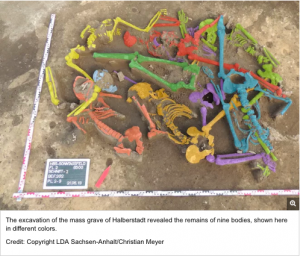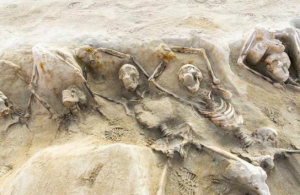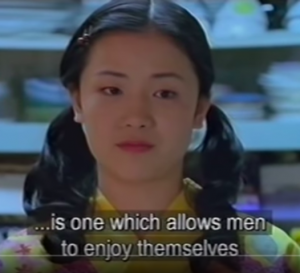The pagan world was horrible: We have had Christian civilisation so long we’ve forgotten to fear pagan barbarism.
By Hilary White
This week, I’ve been thinking a lot about the things the 20th century taught us about human evil and it’s apparent lack of any real internal limits.
We learned a great deal in that century about what the world looks like without Christian moral restraint. This is your society on utilitarian neo-paganism.
From one of the monsters themselves, in the film Nuremberg, a litany of moral crimes of modern post-Christian civilisation.
There’s quite the movement going on right now, especially in Europe, that purports to be a return to paganism. It’s usually depicted as a more or less benign and even appealing hobby for people of poetic or artistic bent – more or less like religious re-enactment societies.
This is, effectively, religious LARPing.
TV shows have helped a lot…
Couple have traditional viking wedding which included blood sacrifice
One Norwegian couple took the traditional wedding to a new level when they decided to exchange vows in an authentic Viking ceremony – complete with longboats, a pagan priest and even a blood sacrifice.
(No blood-eagles were created in the LARPing of this wedding.)
~
Ancient paganism was violent and horrifying beyond most modern western people’s imagining.
The LARPing of at least a sanitised version of ancient pre-Christian religions might be fashionable, and might even seem on the face of it like a bit of harmless fun in a sense – a bit silly, like adults dressing up at Halloween, but harmless amusement. But the pagan, pre-Christian world was really horrible, mainly in the areas we now refer to as “human rights,” even when it didn’t involve “blood sacrifices.”
Simply put, the one unifying characteristic of pre-Christian and non-Christian societies is its all-pervasive lovelessness. The total lack of societal value placed on an individual human life, the acceptance of cruelty and violence. You see it from Meso America to Ancient Rome and China. It is in the never-Christian or post-Christian modern world that slavery and casual abuse of our fellow man is most common and accepted.
Though we might have had some hint of it in the rise of ISIS – the videos of women being sold off as sex slaves, soldiers and civilians being locked into cages and set on fire or drowned, the slaughter of whole populations – the horrors of the ancient world are still nearly unimaginable to us post-Christian, “western” people. Constant warfare that always involved either the total eradication of populations or their enslavement and mass-deporation; the reduction of women to chattel status everywhere, from ritualised temple prostitution to the routine use of slaves for sex; gladiatorial combat; child and adult human religious sacrifice – thought for a long time to by mythical but now being proved by the archaeologists; exposure of unwanted infants…
From archaeology news websites:
A construction group working in Herxheim, Germany, unearthed something completely stunning. Underneath the ground where they had intended to build was a huge pit brimming with dead bodies—more than 1,000 in all.
The bodies had been resting there for over 7,000 years. Whatever happened to them, however, was a horrifying outcome. They hadn’t just been killed. Their skulls had been scraped clean. Their ribs had been peeled from their vertebrae like a butcher preparing up a pig. A portion of the bones had been snapped and the marrow inside sucked out.
These people, it appears, were scalped, cleaned, butchered, and Cannibilized apart. This, however, was no act of desperation by starving people. There were in excess of 1,000 casualties, and the way they’d been skinned was excessively ritualized. This was not a crime of passion or an impermanent pass of mental stability. It was an arranged ritual that an entire community had met up to perform.
…
The Neolithic Genocide In Austria
At a grave in Asparn-Schletz, Austria, a group of archeologists found the remaining parts of 67 people that recounted an horrible story. They had passed on in 5200 BC, running for their lives in what seems to have been the deliberate destruction of a whole tribe.
The individuals were killed running, most beaten in the back of the head, however some were shot down with arrows. Some had their legs crushed and broken to ward off them from getting before their heads were smashed in. Indeed, even the childs were murdered. The bodies of 27 infants lay among the men.
Almost each body, however, was male. Just two women had been laid in the ground. the rest of the women, it’s accepted, in all probability needed to look as their husband and kids were killed. Then they were dragged off. and forced to serve the men who had murdered their families.
…
Shackled Skeletons Unearthed in Greece Could Be Remains of Slaughtered Rebels
Three dozen skeletons in shackles may be the followers of Cylon, an Olympic champion who tried to take over Athens in 632 B.C.
Archaeologists recently found a mass burial in the ancient port city of Phalaeron about four miles from Athens. But this wasn’t just any mass grave—the grouping of 80 skeletons were lined up next to each other, with 36 of them bound in iron shackles. That fact has led some researchers to believe they may be followers of Cylon, a tyrant who tried to take over Athens in the 7th century B.C.
According to Tia Ghose at LiveScience, the area of Phalaeron is a 1-acre cemetery where archaeologists have recovered over 1,500 skeletons. But this most recent group was found in an area being developed for the new National Library of Greece and the Greek National Opera.
It’s easy to shrug and say that Christians have committed atrocities, but the point is that the Christian religion is the first one to tell them categorically that they shouldn’t. That it isn’t the will of God. The very concept that such things are “atrocities” is a Christian idea that would have been incomprehensible to pre-Christian societies. These are simply the things you do in war or for survival, or for your gods.
~
Our friend Dr. Peter K wrote about it the other day: What Christianity and no other religion has brought to the world
Christianity entered into a world that was drunkenly careening from superstition to esotericism, from world-weary despair to unappeasable hedonism, and introduced a way that was lofty, luminous, and liberating. It was truly experienced as a “breath of fresh air,” as good news that gave a new meaning and purpose to life. Christians became known for their kindness and hospitality—and especially, as early documents indicate, for their custom of not exposing infants to death, as the pagans did. Christianity made life worth living again—so much so that it made giving life to others, to offspring, worthwhile too. Unlike the pagans, the Christians did not try to prevent pregnancies or end them, nor did they do away with the “unwanted.” Those who knew that God had looked upon them with love, wanting them for Himself, gained the power to look upon others with love.
It’s been so long since we weren’t a Christian-derived society that for the most part we simply don’t have a cultural memory of what it was like before. The stories that used to be commonly told to children of the deaths and glories of the martyrs – and the consequent understanding of the evils of the old world – are now considered “too scary”. We don’t have categories in our brains to fit ideas about life that were common before – or without – Christ. Only scholars, and not too many of them anymore, still talk about the notion of “pagan fatalism,” the idea you get when you take a loving God out of the picture.
This cultural forgetfulness is why we tend now to look tolerantly on heresy in our own ranks, and to accept with careless beneficence the trend we’re seeing towards a return of paganism. As Christian culture continues to disintegrate both in and outside the Church, our ability to energetically oppose that disintegration is reduced.
But the internet knows, and through it we can now start to see, if we think to look for it, that never-Christian societies have underlying assumptions about the value of the human person that if we really understood them even post-Christian westerners would find repugnant, un-assimilable.
~
This is the only documentary I’ve found about the geisha world that reflects my own impressions of it. The bleak and pointless misery of devoting your youth and life to something utterly superficial and ultimately false, something you know perfectly well to be mean, low and humiliating. And mainly because you live in a society that has no conception of a transcendent God who loves human beings and desires their salvation.
I watch this and unaccustomed phrases come to mind that sound like they come from a feminist tract: “exploitation,” “objectification,” “oppression”…”pedophilia”…
“The maiko and geisha world…
“I like their soft way of talking…
The point of the Maiko is that she is innocent, sweet, “cute,” shy, docile, compliant, weak and helpless and that these give her prime sexual value. The reality of the geisha world is glorifying and normalising nauseating psycho-sexual disorders like pedophilia and bondage/dominance fetishism, covering it over with a sheen of glamour and then elevating it to the highest and most exclusive social spheres.
 They are glamourized and regarded by teenaged girls as otherworldly figures of beauty and refinement. Years of training in music, dance, art and deportment, and hundreds of thousands of yen are spent on their clothes – when a maiko is fully dressed and ready for an engagement she’s wearing about £40,000 worth of clothes. And what is it all for in the end? To party with and titillate rather sleazy old businessmen… to be, essentially, living dolls.
They are glamourized and regarded by teenaged girls as otherworldly figures of beauty and refinement. Years of training in music, dance, art and deportment, and hundreds of thousands of yen are spent on their clothes – when a maiko is fully dressed and ready for an engagement she’s wearing about £40,000 worth of clothes. And what is it all for in the end? To party with and titillate rather sleazy old businessmen… to be, essentially, living dolls.
As one of the men said, “They do everything perfectly. They anticipate your every need…They’ll do anything the client requests. They’re very well trained…
And sometimes to consent to starting “a relationship” with them if they’re good looking enough to be tolerable. For cash.
“Maikos are virgins of course…
“Mizuage” is the Maiko’s “coming of age” ceremony. In the old days, when it was openly accepted, it meant the girl’s virginity was auctioned off by the owner of her house. It still means that, according to the gentleman pictured, but it’s technically illegal so we don’t talk about it.
In the autobiography of one geisha of the old school, published in 1958, she describes the death of one of the other girls:
“… Takemi, died of peritonitis caused by gonorrhea, and her refusal to seek medical treatment in the hopes of hastening her death greatly influenced Masuda’s perception of living as hell and dying as paradise.”
I’ve read part of this book and it makes the world of Dickens’ characters look like a sweet, moral utopia.
And of course, the culture degrades marriage and turns men into creatures like this:
In the mid-1980s it was all the rage among people in my town and my age to study Japanese language and culture. I undertook two years of this in the Pacific and Asian Studies department at uni. At the end of it I realised that this culture was alien, and though I wouldn’t have said so at the time, much of it evil. And that if I continued studying it (I was in a kind of immersion programme) I’d end up alienated from myself.
It was one of my earliest, and hardest, lessons in what was going on. It took a while to start understanding the de-christianisation of our own society was generating the same kind of alienation, not only for me but for many people of my generation stuck living in it. I left the programme because I realised that the alienation I was experiencing was making me ill. But after that, I started seeing the same alienation everywhere. And I continued to be ill for a very long time. Sick from sin, sick from misery, sick from the despair that is paganism’s only existential option, its only answer to evil.
~
In India there is a ceremonial tradition of “Devadasi” that is similar to all this in Japan, though even more depressing, if that’s possible.
This is an account by an Indian government official who tried, and failed, to stop it.
The girls are dedicated, mainly as young children around 8 to 12 years old by her parents, seeking the intervention of the goddess in their affairs. It could be a serious sickness in the family, when the parents vow to dedicate a daughter praying the goddess to bring healing; or it could be a prayer wanting a son; or to overcome a financial difficulty or simply to get rid of a superfluous daughter…
The girls are taken to the ponds near the temple, given ritual bath, made to wear only neem tree (Margosa tree) leaves as dress and with a pot full of water on their heads, made to climb the hill to the temple. Of course the path is lined by ogling young boys and men. In the temple, the priests amidst rituals tie around the neck of the girl, a thread with beads, taken from the goddess’ neck. Now she has become married to the goddess and enters into the service of the deity, serving her by singing and dancing and worshiping. Such girls are forbidden to marry any mortal.
So far so good; but what happens in reality after this marriage to the deity is sickening. The girl is taken in by the temple poojari (priest) first or by the landlord or a rich man of a village, the highest bidder. The patron pays lump sum money to the parents of the girl, pays for the ceremony and also maintains the girl. She may be kept as his mistress for a year or more, till he is tired of her or finds a new girl. Thereafter the girl really enters into prostitution to eke out her livelihood, with any and every one. These girls are forbidden to claim to be a wife of any one man. The children born out of such unions are given the surname of Basava, the goddess. Virginity of a girl is offered as an offering to the goddess. They become the female prostitutes attached to the temple; there are male prostitutes also.
The internet has introduced whole swathes of post-Christians to the cultures of never-Christian lands, and the responses are always the same expressions of horror and disgust.
This story appeared last week in the UK tabloid The Sun: “SICK AUCTION – ‘Virgin bride’ sold to highest bidder on Facebook for 500 cows, three cars and £7,500 in ‘barbaric slave market’.
It might be “sick” but it is also normal in the non-Christian world, and it was normal in the pre-Christian world.
Though modern, secularised post-Christians can’t seem to find solid ground to object to it, while maintaining their pose of relativistic, faux cultural neutrality…
A Facebook spokesman told Thomson Reuters Foundation: “Any form of human trafficking whether posts, pages, ads or groups that co-ordinate this activity are not allowed on Facebook.”
George Otim, Country Director of Plan International South Sudan, said: “This barbaric use of technology is reminiscent of latter-day slave markets.
“That a girl could be sold for marriage on the world’s biggest social networking site in this day and age is beyond belief.
“While it is common for dowries to be used in marriages in South Sudanese culture, nothing can excuse the way this girl – who is still a child – has been treated as nothing more than an object, sold off to the bidder prepared to offer the most money and goods.”
Monica Adhiue, from South Sudan’s National Alliance for Women Lawyers, condemned the auction as “shocking and sad.” She told VOA’s South Sudan in Focus: “The practice is a gross human rights violation and violates the rights of a girl.”
While secular NGOs – their worldview founded on anti-rational, relativistic ideology – struggle to find a moral standard by which to condemn this ancient cultural practice…
…in modern Germany the full embrace of those ideologies have resulted in the state itself becoming a pimp…
‘If you don’t take a job as a prostitute, we can stop your benefits’
A 25-year-old waitress who turned down a job providing “sexual services” at a brothel in Berlin faces possible cuts to her unemployment benefit under laws introduced this year.
Prostitution was legalised in Germany just over two years ago and brothel owners – who must pay tax and employee health insurance – were granted access to official databases of jobseekers.
…
She received a letter from the job centre telling her that an employer was interested in her “profile” and that she should ring them. Only on doing so did the woman, who has not been identified for legal reasons, realise that she was calling a brothel.
Under Germany’s welfare reforms, any woman under 55 who has been out of work for more than a year can be forced to take an available job – including in the sex industry – or lose her unemployment benefit. Last month German unemployment rose for the 11th consecutive month to 4.5 million, taking the number out of work to its highest since reunification in 1990.
The government had considered making brothels an exception on moral grounds, but decided that it would be too difficult to distinguish them from bars. As a result, job centres must treat employers looking for a prostitute in the same way as those looking for a dental nurse.
When the waitress looked into suing the job centre, she found out that it had not broken the law. Job centres that refuse to penalise people who turn down a job by cutting their benefits face legal action from the potential employer.
~
And it’s everywhere in what we used to refer to as the “western world” – formerly known as Christendom.
This is New Zealand:
This is what really happens when prostitution is decriminalised
The application form for opening a brothel in New Zealand is just two pages long: three pages shorter than the form needed to adopt a dog or cat from Battersea Dogs & Cats Home…
The hardest battle I have ever fought as a feminist campaigner against male violence is against the expansion and normalisation of prostitution. During research for my book, in which I seek to expose the truth about the sex trade, I encountered a twisted version of reality – propagated by the so-called “sex worker’s rights” movement – that rebrands and sanitises the sex trade as a harmless service industry.
During two years I travelled 164,000 miles, interviewing 250 people around the world. The biggest obstacle I faced was the well-oiled propaganda machine that takes the truth about the sex trade and represents it to the world in the form of sanitised sop.
…
New Zealand is regularly held up as the gold standard model of how to eradicate problems inherent to prostitution. In 2003 its government voted (by a majority of one) to decriminalise pimping, brothel owning and sex buying. The argument, led by the New Zealand Prostitutes Collective (NZPC), was as persuasive as it was misleading: removing all criminal laws from all aspects of the trade would lead to “worker’s rights” and safety for the women. Handily for sex trade entrepreneurs, this resulted in pimps and brothel owners being rebranded as “businessmen”. I heard a legal pimp in Nevada refer to his “business” as similar to that of McDonalds. Except in the case of prostitution, human beings, not dead flesh, are the product for sale.
Alongside other countries and states that have removed criminal penalties against sex trade exploiters, such as Holland, Germany, Nevada (US), and some states in Australia, New Zealand helped to make selling sex as respectable and devoid of red tape as selling cars.
~
This is what the “new paganism” is really about, and it’s pretty much indistinguishable from the Old Paganism.
I just discovered a thing I did on it for LSN six years ago that I’d completely forgotten about:
A look at the global situation, the jurisdiction of the Vatican, shows a dismal vista for the family based on marriage. Marriage is under massive pressure from two directions. In the West, the growth of a relativistic philosophy and radical secularism have resulted in the state chipping away at the rights and legal protections of the family on one side and the meaning and nature of marriage in law on the other.
From the East, the pressure comes from a totally different, non-Christian paradigm of marriage that does not hold the same foundational concept, that of a monogamous relationship of love and mutual fidelity between one man and one woman – persons of equal dignity – for life. In many countries of what used to be called the Orient, including the Middle East, South and West Asia and the Far East, a more commercial and materialistic foundation is considered the norm, and in Islamic countries, these differences become radical.
…
Behind the primacy of the family lies a uniquely Christian idea. The reason the family is so important a defining feature of our societies is that it is founded in the concept of the equal moral dignity of all persons. The reason family traditionalists are nearly always also pro-life, the reason that the two go hand in glove, is that the two proposals, the primacy of the family and the right of the unborn and vulnerable to life, are founded on the same principle: that all human beings, regardless of their age, abilities, social status, anticipated income, nationality or state of “wantedness,” are persons entitled to precisely the same protections under the law.
…
Taking the longer historical view, however, the idea that the pro-life and pro-family point of view is “retrograde” is heavily ironic. We in the Western World have been Christianised for so long that we have unconsciously subsumed these civilisation-building principles without being able any longer to articulate and define them. We have had our civilisation for so long that we have forgotten the barbarism it defeated and tamed. The result of this societal amnesia is that we are increasingly condemning as “retrograde,” or “oppressive” the very concepts that built, nurtured and protected our society.
So immersed are we in these foundational ideas, we have little insight to imagine a society not run on Christian moral principles. Beginning history students, even those who regard themselves as “emancipated” and secularised, are often shocked by the ideas that were considered normal in the ancient world.
In the world before Christianity, the idea that all human beings are equal under a divinely authored Natural Law was a wild innovation, an unprecedented and revolutionary novelty in an ancient world that had, since the dawn of history, universally accepted slavery, women and children as chattel and routine infanticide at the whim of parents.
On the other hand, nearly all the ideas so frequently championed by our philosophical opponents were part of the normal fabric of life in the ancient world; violent, brutal and arbitrary as it was. The notion that one spouse could dispose of the other at whim by a “no fault” system of divorce; that one parent, without being obliged even to consult the other, could decide which child would live and which would be “exposed”; that merely being human was not sufficient grounds to bestow the legal protection of the state: all were among the uglier aspects of Roman law. The notion that a man’s wife and children, slaves and dependent “clients” were possessed of exactly the same dignity and legal status as he was, would have shocked a Roman patrician of the 2nd century. As it would an Indian Brahmin of the 10th or a Confucian scholar-official of the 12th.
Only Christianity, and Christian philosophy and jurisprudence, has ever proposed to treat financially or physically or socially unequal human beings equally in law. The very concept of “person” in law did not exist until it was developed by Christian philosophers who also developed the notion of “human rights” based on nothing more than membership in the species, made in the image of the author of all creation.
And now Pope Benedict is sounding the alarm that those Christian concepts of law and philosophy are being rejected by governments, on so fundamental a set of priorities as the nature of the family. What is to stop our societies from sliding all the way back to our retrograde, and violent, pagan past?
~















